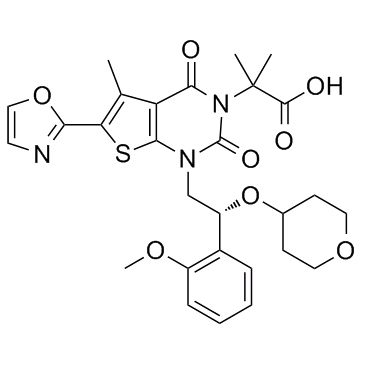| Cas No.: | 1434635-54-7 |
| Chemical Name: | ND 630; ND630,GS-0976,GS 0976,GS0976,firsocostat |
| Synonyms: | ND 630; ND630,GS-0976,GS 0976,GS0976,firsocostat |
| SMILES: | CC1=C(SC2=C1C(=O)N(C(=O)N2C[C@@H](C3=CC=CC=C3OC)OC4CCOCC4)C(C)(C)C(=O)O)C5=NC=CO5 |
| Formula: | C28H31N3O8S |
| M.Wt: | 569.63 |
| Sotrage: | 2 years -20°C Powder, 2 weeks 4°C in DMSO, 6 months -80°C in DMSO |
| Description: | Firsocostat (ND-630; GS-0976; NDI-010976) is an acetyl-CoA carboxylase (ACC) inhibitor; inhibits human ACC1 and ACC2 with IC50 values of 2.1 and 6.1 nM, respectively. |
| In Vivo: | Chronical administration of Firsocostat (ND-630) to rats with diet-induced obesity reduces hepatic steatosis, improves insulin sensitivity, reduces weight gain without affecting food intake, and favorably affects dyslipidemia. Chronical administration of Firsocostat Zucker diabetic fatty rats, Firsocostat reduces hepatic steatosis, improves glucose-stimulated insulin secretion, and reduces hemoglobin A1c (0.9% reduction). Firsocostat exhibits an aqueous solubility of 594 μM and human and rat plasma protein binding of 98.5% and 98.6%, respectively. Pharmacokinetic evaluation of Firsocostat in male Sprague-Dawley rats [i.v. 3 mg/kg; orally (p.o.) 10 mg/kg] yields a plasma t1/2 of 4.5 h, bioavailability of 37%, clearance of 33 mL/min/kg, volume of distribution of 1.9 L/kg, oral time of maximum plasma concentration of 0.25 h[1]. |
| In Vitro: | Firsocostat (ND-630) inhibits hACC1 (IC50=2.1±0.2 nM) and hACC2 (IC50=6.1±0.8 nM). Inhibition is reversible and highly specific for ACC. Firsocostat inhibits ACC activity by interacting within the phosphopeptide-acceptor and dimerization site of the enzyme to prevent dimerization. Firsocostat inhibits fatty acid synthesis with an EC50 of 66 nM in HepG2 cells without altering the total cell number, cellular protein concentration, and incorporation of acetate into cholesterol[1]. |

 DC Chemicals' products qualify for U.S. tariff exemptions. We guarantee no price increases due to customs duties and maintain stable supply, continuing to deliver reliable research solutions to our American clients.
DC Chemicals' products qualify for U.S. tariff exemptions. We guarantee no price increases due to customs duties and maintain stable supply, continuing to deliver reliable research solutions to our American clients.





















